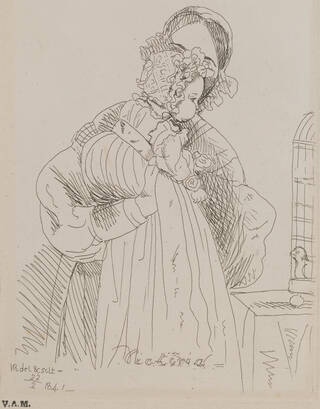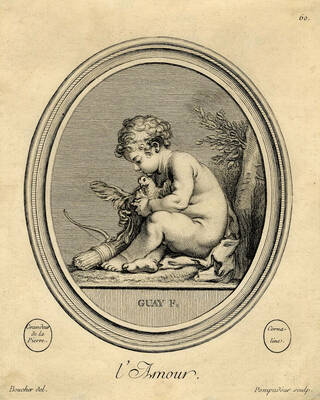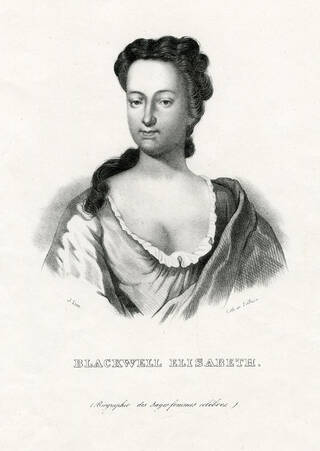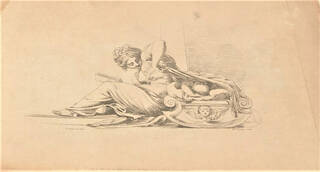Women have made prolific contributions to the medium of print for centuries: from noble women learning a new skill to amuse their friends, to women using print as a means of income, to women painters experimenting with a new medium. This brief introduction highlights just a small number of female printmakers who worked with the medium from the 1700s through to the 1930s.
A noble pursuit
In the 18th and 19th centuries, printmaking was seen as an acceptable way for women of noble birth to engage with the arts. A natural extension of their schooling in drawing, printmaking allowed high ranking women to delight their friends, families, and suitors with their charming artistic endeavours.
Queen Victoria
Introduced to the arts at a young age, Queen Victoria (1819 – 1901) was instructed in drawing and painting, producing her first watercolour at age eight. She continued to draw and paint throughout her youth, even sketching a self-portrait after her coronation in 1837. However, it wasn't until her marriage to Prince Albert in 1840 that her passion for the arts was truly ignited.

While pregnant with their first child, the couple installed an etching press in their home at Buckingham Palace. They sought assistance from master printmakers who not only taught the couple how to etch, but also undertook the difficult work of preparing the plates for printing. Though her first etching was a copy of a painting in the royal collection, Victoria's prints were often used to document her life as a wife and mother, depicting her children and pets. Despite finding the process of etching complicated, Victoria was much more taken with print than her husband. She produced over twice the number of prints than Albert – up to 62 – before her death.

Madame de Pompadour
Like Queen Victoria, Madame de Pompadour's (1721 – 64) love of the arts was exacerbated by a famous man in her life – King of France Louis XV – though it certainly did not begin with him.

Born Jeanne-Antionette Poisson, Madame de Pompadour developed an interest in the arts in her early 20s. Setting up a gathering for artists and intellectuals at her home outside of Paris, she was able to meet the artistic minds of the day. However it wasn't until 1745, when she met the King of France Louis XV and moved into the palace at Versailles, that she was given the space to explore her passion further and begin her long and illustrious patronage of the arts.
She was taught to engrave gems by Engraver to the King, Jacques Guay, and learnt printmaking from masters such as François Boucher. She also had a printing press installed in her apartments where she created 52 engravings after Boucher and Guay. These prints were intended as gifts for a select group of friends, including the King.

Women of industry
While women of noble birth were producing prints for entertainment and pleasure, women of lower rank in society were using printmaking as a means of income. Utilising the skills that they had at their disposal, often acquired from their schooling in drawing, these women were able to create, publish, and sell prints to generate revenue.
Mary Darly
Mary Darly (about 1736 – 91) pioneered a new form of print in the 1750s – that of the caricature or 'macaroni' – based on the extravagant male fashions of the time. Running a print shop and publishers alongside her husband, Matthias Darly, Mary published prints by both amateurs and professionals, men and women. The Darlys understood the difficulties faced by women as printmakers and knew how to give them a place in a genre prejudiced against women. Whether it was allowing women to publish work anonymously or offering discreet personal printing tutorage at the pupil's own home, Mary Darly found ways for women to publish prints so that they could earn a living without damage to their reputation.

Ironically, it was the discreet nature of this practice that meant many women printmakers have remained undiscovered. Prints made by Mary Darly herself were often misattributed to her husband owing to her signature of M. Darly.

Elizabeth Blackwell
Unlike her peers, Elizabeth Blackwell (about 1700 – 58) turned to printmaking out of necessity rather than pleasure. It is likely that she was taught to draw in her early years, as was standard at the time for accomplished young ladies. However, it wasn't until her husband found himself in debtors' prison that Blackwell turned to printmaking to secure an income.

Spotting a gap in the market for reference books for apothecaries, Blackwell studied the herbs in Chelsea Physic Garden and produced a book containing a total of 500 prints, etched and coloured by herself, named A Curious Herbal. These eventually allowed Blackwell to make enough money to release her husband from prison. However this did not last, and before long Alexander Blackwell was in debt again, leading Mary to sell the rights to her prints for more money.

A family affair
Many female printmakers were introduced to the medium by the men around them. Often already established in the field, this tutorage and association with their male peers allowed them a head start in the industry. Like many vocations at this time, their trade was inherited.
Elizabeth Judkins and Caroline Watson
Aunt and niece, Elizabeth Judkins (about 1756 – 1819) and Caroline Watson (about 1760 – 1814) were likely taught to print at the same time by Caroline's father and Elizabeth's brother-in-law, James Watson. Specialising in mezzotint, Watson showed the women the tonal engraving technique so they might assist in the workshop.
Publishing her first print in 1770, Judkins is known as England's first female mezzotint engraver and the only professional woman printmaker of the time to exhibit her prints. Following in the footsteps of her teacher, Judkins produced portraits, which were mostly of women. Interestingly, both James Watson and Elizabeth Judkins were published in the same print catalogue, however, where Watson was named as printmaker, Judkins was not.

Caroline Watson became one of the most prolific printmakers of the 1790s, eventually gaining the title of Engraver to the Queen. Unlike her aunt and father, Caroline specialised in stipple engraving (a technique which uses different sized dots to achieve tone), capitalising on the popular reputation of the medium. In 1785 she self-published a print of Princess Mary, a strategic move which allowed Watson to make a name for herself by catering to female clientele. Judkins and Watson eventually formed an exclusively female household, allowing them to continue as printmakers and provide support to each other as unmarried women in the 18th century.

Letitia and Elizabeth Byrne
The daughters of successful printmaker William Byrne were trained to print by their father, benefiting from his extensive artistic network. Beginning training at a young age, Letitia (1779 – 1849) had a set of 13 etchings after the old masters published when she was only 14-years-old.
Though Letitia began her life as a printmaker by copying the works of the old masters, both her and her sister Elizabeth (1784 – 1874) eventually followed in the footsteps of their father by producing landscapes. Unlike her father, who was an engraver, Letitia used the medium of etching to execute her landscapes, which was a popular technique at the time. Elizabeth, however, continued to use engraving, honouring the teachings of her father.

Painter-printmakers
In the 18th and 19th centuries, women such as Angelica Kauffman and Maria Cosway became household names as painters, although their contribution to the medium of print was extensive. Their fame amongst the upper classes was carefully cultivated, allowing them to thrive in the profession whilst maintaining their feminine sensibilities.
Maria Cosway
Unlike some women supported and celebrated by their male family and partners, Maria Cosway (1759 – 1838) had to fight against her domineering husband. Having come to London to capitalise on the burgeoning print market, she married miniaturist Richard Cosway who allowed her to exhibit her paintings, although not to work professionally as a painter. Despite this he allowed her to make prints after his own work, including her Imitations in Chalk series. Published in 1800, these contained increasingly religious subject matter, portraying her grief after the loss of her daughter in the late 1790s.

Like many other women artists at the time, Maria began her career by copying the works of her established peers. Though as she progressed, she began creating original works of art, mainly depicting women and children. Maria turned to the technique of etching to produce these works, allowing her to utilise her drawing and painting skills in a medium that was approved of by her controlling husband.

Angelica Kauffman
Trained in Italy and considered a talented young artist, Angelica Kauffman (1741 – 1807) made her earliest identified print – the first of 41 plates – around 1762. She moved to London in 1766 and within two years was elected as a founding member of the Royal Academy, one of only two women at the time to do so.

Her prints primarily focussed on two subjects: responses to paintings by old masters (often containing women), and portraits. This allowed her to ingratiate herself with upper-class clientele by focussing on subjects that they were familiar with, whether it be famous paintings or celebrities of the day. Some of Kauffman's most interesting prints are her female personifications of John Milton's poems, L'allegro, and Il Penseroso. Though she was not the first to imagine the characters as women rather than men, these prints show her clear interest in female subjects.
Impressionist impressions
Moving into the 20th century, a new obstacle was presented. Though female artists were becoming more prevalent, the popularity of printmaking as an artform dwindled. Often seen as lesser due to its reproductive nature, prints were overlooked in favour of original artworks.
Mary Cassatt
Known as the mother of modern print, Mary Cassatt (1844 – 1926) is often mistakenly credited as the first woman printmaker. She spent her childhood between America and France, and it was in France that she met Impressionists such as Edgar Degas (1834 – 1917) who encouraged her to experiment with print. By 1880 she was exhibiting her first prints alongside famous Impressionists such as Édouard Manet and Berthe Morisot.

Women were an integral part of Cassatt's subject matter, though unlike printmakers of the 18th century, Cassatt made observations of everyday women such as mothers and working women. For example, her dry point etching titled La leçon de crochet shows a mother teaching her daughter how to crochet. These intimate moments between women were central to Cassatt's work.

Berthe Morisot
Mary Cassatt had a strong hand in encouraging fellow Impressionist Berthe Morisot (1841 – 95) to take up print. Morisot did not pick up an etching needle until late in her career, at which point she was already an established painter, having been the only woman to exhibit at the first ever Impressionist exhibition in 1874.

Morisot began printmaking around 1878, mainly keeping prints to share with family and friends, meaning they were never exhibited during her lifetime. She made eight prints in total and only ever printed a proof state of each as a test print. All surviving dry point etchings made by Morisot were printed by art dealer Ambroise Vollard, from plates which were likely never intended to be seen. Unlike her male counterparts, though similar to Cassatt, Morisot's work had a distinctly feminine touch, focussing on depictions of women, especially in later years her daughter.

Pioneers of print
As etching became less popular, relief printing such as wood engraving became fashionable. These could be made on a small scale to be reproduced for book illustrations and pieces of art. Passionate female printmakers pioneered the technique, producing vast numbers of prints in a way that they had never been able to before.
Gwen Raverat
Associate of the revolutionary Bloomsbury group, Gwendolen Raverat (1885 – 1957) inherited her grandfather Charles Darwin's love of the natural world. Encouraged by her American mother to pursue the opportunities afforded to women at the time, Raverat was taught to draw from an early age. Despite this, it wasn't until she taught herself wood engraving in the early 1900s that she truly found an art form that fascinated her completely. This love of the technique led Raverat to become the only female founding member of the Society of Wood Engravers, which still exists to this day.

Clare Leighton
One of the most industrious printmakers of all time, Clare Leighton (1898 – 1989) carved more than 900 woodblocks throughout her life. With the end of the First World War bringing about new and exciting opportunities for women, Leighton was able to thrive in the art world. Attending Brighton Art School, Slade School of Art and Central School of Arts and Crafts to learn wood engraving, she then began her career as an illustrator, providing prints for her father's books. Leighton's work ethic is reflected in her subject matter where she focuses on group portraits of physical labourers such as washer women and lumberjacks.
.jpg)
Throughout history the medium of print has allowed artists the means to disseminate their vision across the world. Women have capitalised on this through the centuries, using print to bring their ideas and passions to life.
Visit the Prints and Drawings Study Room to see more prints by women in our collections.




